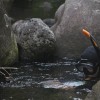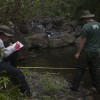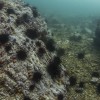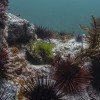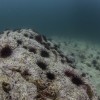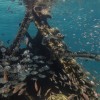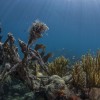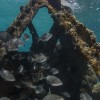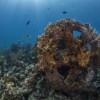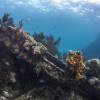From American Samoa to Washington D.C.
My last destination on my adventure led me to American Samoa; arriving on the island after a five-hour flight from Hawaii felt like landing on the edge of the world. It was certainly the farthest west I’d ever been, and my first time in Polynesia. I had been expecting a small island, similar to what I experienced in Kalaupapa, but I was soon overwhelmed by the size and culture of American Samoa. The island was a mix of traditional Samoan culture overlaid by American Westernization. The result? A vibrant, colorful community with both traditional values, modern culture and a stunning landscape.
Pola Island with Red-footed Boobies flying overhead.
Upon my arrival to the island I met with Tim Clark, a marine ecologist in the park. He quickly introduced me to my roommates for the next three weeks: Ian Moffitt, Karen Bryan, Caitlyn Webster and Kersten Schnurle. These four interns arrived around the same time as I did, and were on a mission to kill Crown-of-Thorns starfish, or COTs. Many of the parks I’d worked in had problems with invasive species; in Yellowstone it was lake trout, in Biscayne it was lionfish, and in Crater Lake crayfish were the invasive nuisance. American Samoa’s problem with COTs was unique in that the starfish are a native species, but their population surges or outbreaks have a devastating impact on coral reefs. It’s theorized that increased nutrient runoff from farming and industrialization, combined with strong weather events such as the 2009 typhoon, created a perfect storm for the starfish population to grow unchecked. This is bad news for coral, as the problematic starfish eat hard corals, leaving white skeletons in their wake. 
Some of American Samoa’s beautiful coral specimens.
So with our mission the other interns and I set out to find the COTs outbreaks. To do this we utilized a survey technique called tow-boarding, where two people were towed behind the boat and signaled each time they saw an outbreak. We started tow-boarding in the park, and continued all across the north side of the island, documenting outbreak locations, intensity and depth.
Once we knew where the Crown-of-thorns starfish outbreaks were, we set out to manage the population. To do this injected each COTs with a mixture of water and powdered ox-bile. The ox-bile mixture disintegrates the starfish, and leaves no impact on the reef. Don’t ask me how someone thought to use bile from ox to kill starfish, but hey, it works!  My first dive with the injector was a lesson in task-loading; in addition to carrying our regular scuba gear, we were also equipped with a weighted container of the ox-bile mixture attached to a long injection needle. It was quite a challenge to keep everything sorted out, but I adapted and even managed to kill 11 COTs! It wasn’t quite the record of 100+ on a single dive, but I felt better knowing that I had eliminated at least part of the problem. Diving and tow-boarding in American Samoa gave me the chance to see corals I’d never seen before. The waters of American Samoa boast over 200+ coral species, and being there to see the beautiful reefs was a special privilege.
My first dive with the injector was a lesson in task-loading; in addition to carrying our regular scuba gear, we were also equipped with a weighted container of the ox-bile mixture attached to a long injection needle. It was quite a challenge to keep everything sorted out, but I adapted and even managed to kill 11 COTs! It wasn’t quite the record of 100+ on a single dive, but I felt better knowing that I had eliminated at least part of the problem. Diving and tow-boarding in American Samoa gave me the chance to see corals I’d never seen before. The waters of American Samoa boast over 200+ coral species, and being there to see the beautiful reefs was a special privilege. 


 Halfway through my stay we were joined by Ana Sofia Guerra, the current North American Our-World Underwater Scholar. It was great meeting and catching up on each other’s adventures; what are the odds of meeting halfway across the world?! I also had the opportunity to explore some of the delicious food (and ice cream!), beautiful views and even native fauna. My second evening in American Samoa introduced me to Malie, a baby Samoan fruit bat that had been separated from its mother and was being rehabilitated by the Department of Marine and Wildlife Resources. I completely forgot about my fear of bats, and even held her for a while. Samoan fruit bats are an important part of Samoan culture, and grow to have a wingspan of three feet wide!
Halfway through my stay we were joined by Ana Sofia Guerra, the current North American Our-World Underwater Scholar. It was great meeting and catching up on each other’s adventures; what are the odds of meeting halfway across the world?! I also had the opportunity to explore some of the delicious food (and ice cream!), beautiful views and even native fauna. My second evening in American Samoa introduced me to Malie, a baby Samoan fruit bat that had been separated from its mother and was being rehabilitated by the Department of Marine and Wildlife Resources. I completely forgot about my fear of bats, and even held her for a while. Samoan fruit bats are an important part of Samoan culture, and grow to have a wingspan of three feet wide!
It was with a heavy heart that I left the stunning diving and my newfound friends in American Samoa, and headed to Washington D.C. to present my work from my internship. My travel from American Samoa to D.C. was a huge undertaking; I flew from American Samoa –> Honolulu –> Portland, OR –> Houston, TX –> Washington, D.C. Whew! Once in D.C. I met with Cliff McCreedy, the Marine Resource Management Specialist in the Oceans and Coastal Resources Branch of the Park Service. Cliff had generously taken the time to schedule several meetings for me throughout the week, so I had the opportunity to present my work to Ray Sauvajot, Sande McDermott, Stan Bond, Julia Washburn, Lynne Murdock and Don Wollenhaupt. I was quite nervous about presenting to such an impressive and diverse group of decision makers, but they were all generous with their time and eager to hear about my adventures. I also had time to visit the Oceans Hall in the Smithsonian Museum of Natural History, and even met with Emily Frost, a Smithsonian Ocean Portal editor, writer and producer, and Nancy Knowlton, the Sant Chair for Marine Science. What an honor!
 Meeting with Julia Washburn, the Associate Director for Interpretation, Education and Volunteers. Quite a difference from my usual outfit of a t-shirt and shorts!
Meeting with Julia Washburn, the Associate Director for Interpretation, Education and Volunteers. Quite a difference from my usual outfit of a t-shirt and shorts!
I’m now back home in New Hampshire, and I still can’t believe that this incredible opportunity has come to a close. Traveling across the United States has been a whirlwind of an adventure, and it feels like just yesterday I was just gritting my teeth against the cold water of Yellowstone Lake, or watching Red-footed Boobies wheeling overhead in American Samoa. To capture the breadth of my experiences I’ve put together a website chronicling my adventures; click here to view my website and browse through my blog posts, photos and 3D models.
I know it will take many months, perhaps even years, to fully process all that I’ve done and realize the impact that this internship has had on my career. I continue to be astounded by the generosity of the National Park Service and the Our-World Underwater Scholarship Society as they continue to mentor and advise me on my next adventure. My heartfelt thanks go to both organizations, as without their support I wouldn’t be the aquanaut that I am now. Also many thanks to the amazing people I’ve worked with throughout the past five months; I was amazed by our country’s underwater resources, but I was truly awed, humbled and inspired by the people who protect them.
Thank you.
~Yasmeen Smalley
Farewells
Hello all!
So its officially been three weeks since my internship ended, and I thought I would do a final update to reflect on the whole experience and talk about my last few weeks as the AAUS Summer Intern. I think it took me this long to write my final post because of the wealth of activity that went on this summer; from earning four different scuba certifications, to working on three different scientific projects, and transforming my scuba knowledge into a teachable skill, the ways that I’ll practice scientific diving have been forever changed. Moreover, being the first experience I had post graduating from Williams College, it was formative in the way that it pushed me into the real world while still allowing me time to refocus in the beautiful Maine setting. Now in Boston, I find it hard to tell people exactly what I was doing between graduating from college and starting now as an intern at the New England Aquarium. It definitely was an amazing and educational experience for me, and proved that science diving is exactly what I hope to do with my life in the future.
Not only did I have a great time learning and working there, but I met some amazing people who inspired me to continue on in the hopes of becoming a working marine biologist. In a field that can be at times competitive and at times isolating, its great to meet others who push forward with their work and enjoy it as well. My many coworkers and fellow students really helped shape my experience. Not the least of which include my two mentors / bosses for the summer Chris Rigaud and Rick Wahle. I also received generosity from those outside my immediate campus in Walpole, including Jenna Walker and the OWUSS staff who led me through the summer, the AAUS community who supported my continued stay in September, and USiA, who provided me with a drysuit to learn from.
In my last few weeks at U.Maine my main occupation was helping to teach the Science Diving course. This experience was one of the most influential of the entire experience, because it acted as a refresher and summary course for all of the work I did over the summer to earn AAUS certification and Divemaster. I heard once that the way to learn something is to “See it, Do it, Teach it” and this class gave me the opportunity to really see all of the lessons at once. Whether it be ensuring hoses are hooked up, knowing the exact inner workings of your gear incase something goes wrong – especially how to lace a BCD strap – or knowing your body so that the constant ascents and descents required to test a class don’t interact with a lingering cold. You’re own kit and preparation have to become second nature if you’re preoccupied with making sure everyone else around you doesn’t forget to turn their air on.
Here are some photos of me on the job, just to prove it really happened!
Now I’ll be in Boston working at the New England Aquarium as a Giant Ocean Tank Intern, so if you want more updates just drop by some weekend and wave at me through the glass! At the aquarium I prep food and help maintain the health of the inhabitants of the faux coral reef tank. The 200,000 gallon tanks hosts dozens of different species of fish, four turtles, four sharks, and four rays. The animals eat approximately 40lbs of food every day that I help prepare in the mornings. I dive approximately twice a day in the tank, and with my training this summer I quickly passed my check-out dives and have begun hand feeding a few of the species in the tank. My increased buoyancy control helps me navigate the small pathways carved through the exhibit and my summer in 40 degree saltwater has me now spoiled in the 75 degree tank. Many of the skills I learned this summer transfer beautifully into the tank, including the suction sampling which will help me learn to vacuum the sand at the bottom of the tank. My increased understanding of gear helps me feel comfortable wearing aquarium gear instead of my own, who also prefer the harness style BCD instead of the normal jacket. And nothing can diminish the benefit of feeling comfort in the water that I attained this summer in Maine, which helps me keep calm and stoic when so many visitors are watching!
Maybe I’ll see you sometime in Boston but until then, thanks for the great summer.
Katy
The Living Resources of Kalaupapa
Getting from Valor in the Pacific in Oahu to Kalaupapa National Historical Park in Molokai was probably the easiest transit from park to park I’ve had yet! The two islands are only 30 minutes away by air, so with a quick taxi ride to the airport I was on my way to Kalaupapa. The airline was a private charter service, and I got to sit in the cockpit! I’m still very much a child at heart, so it was incredibly exciting.
Once I arrived I met with Eric Brown, the marine ecologist at Kalaupapa and Sly Lee, a marine biological science technician in the park. After a quick tour of the office, Sly took some NOAA researchers and me on a tour of the park. We saw the original settlement, the church where Father Damien preached, the world’s tallest sea cliffs, and the original and still functioning lighthouse. Majestic can’t even begin to describe the natural beauty of the park.
Sly also gave me some background on the park’s history. The settlement was established in the late 1800s as a colony for those with Hansen’s Disease, or leprosy. Native Hawaiians on the peninsula were displaced as the government began the forced exile of those afflicted with leprosy to Kalaupapa, tearing them away from their homes and forcing them into colonies of isolation. This isolation continued until the 1940s, when a cure for leprosy was found, and the government began to ease the isolationist policies. In 1980 Kalaupapa National Historical Park was created to preserve the history of the settlement, and maintain the home of the remaining patients. Today the park is a quiet haven to protect the biological and cultural resources. More importantly, the park also exists to protect and preserve the memories of the patients, who are the last survivors of this terrible legacy.
After I got acquainted with the resources on land, it was time to explore the resources underwater! I quickly put together my underwater camera setup, and enjoyed the unbelievably crystal-clear waters of Kalaupapa. This was my first experience in warm Pacific waters, and I was loving every moment.
My first day in Kalaupapa concluded with community volleyball, a wonderful tradition that happens every Wednesday and Saturday evening. My volleyball skills (or lack thereof) were quite embarrassing, but everyone was encouraging and there to have a good time, regardless of skill level. It was a great way to meet some of the settlement’s 90 residents!
The work week started with the arrival of two University of Hawaii at Hilo researchers, Lindsey Kramer and Kerrie Krosky. Their research involved assessing algae growth and the impact of algal predation from different kinds of marine organisms. The data and research also assessed algal growth on a larger scale in relation to location and causes, such as nutrient runoff from agriculture. I was very impressed by the scope of the research, as well as its implications. For their work here in Kalaupapa we were diving on fixed sites and meticulously collecting algae using an underwater vacuum. Each dive was almost two hours long and required constant attention and concentration, but it was a great challenge to test my scientific diving skills.
Eric (left) and Lindsey collect algae on a fixed site in Kalaupapa.

Luckily diving wasn’t all work and no play- I had a delicious coconut break after a long day of diving! Kalaupapa is home to countless coconut palm trees, as well as mango, banana, papaya, mountain apple, lemon and avocado trees, to name a few. Each day usually featured a healthy and delicious snack break!
Halfway through the week Lindsey, Kerrie, Sly and I joined Carrie Mardorf, the Cultural Resources Program Manager at the park to photograph the Supermoon. We watched the moon rise over the sea cliffs and reflect over the waves. Witnessing special events in nature such as this definitely reminds me how lucky I am!
At the end of the week I joined Eric on a monk seal survey, which involved two hours of hiking along the rocky shoreline to observe and record monk seal activity. Monk seals are an endangered species, and the long-term monitoring helps determine habitat preference and seasonal preference over time in Kalaupapa. Our first hour of hiking yielded no monk seal sightings, but luckily during the second hour we saw two adults and a mother and pup seal! I had observed pinnipeds in the Channel Islands, but this experience impressed upon me the need for research, to preserve pupping areas.
After another rousing game of volleyball on Saturday, the next week began by preparing for a five-day camping expedition to Waikolu Valley to perform stream surveys. Eric, Sly, Randall Watanuki, the park’s maintenance mechanic and boat operator and I were joined by Dave Raikow, an Ecologist with the Pacific Island Network Inventory and Monitoring National Park Service, and Anne Farahi, a Biological Science Technician with the same organization. Our mission for the week was to collect water quality samples, perform fish and snail surveys and monitor the current at fixed and temporary stream sites throughout the valley. This was a great opportunity for me to gain experience in terrestrial research!
- Anne performs a fish survey in the stream
- Sly records water quality data
- Dave and I measure stream velocity
Each morning would begin with a briefing on the day’s activities, and then we would begin our hike to the first site of the day. Our route took us through a tropical forest, and the first few days involved bushwhacking our way through the dense clusters of guava, coffee and kukui nut trees. Each morning was a sensory experience as we fought off prickly lantana bushes, inhaled the sour-sweet smell of overripe guava and heard the occasional squeal of a wild pig in the distance. The days were long and physically exhausting, but the view on returning to our campsite each evening never failed to inspire me.
After our week in Waikolu was over we said farewell to Dave and Anne, and Sly and I went on some photo dives to practice our 3D modeling. I had produced a few models in Pearl Harbor, but was eager to try my hand at modeling corals. Sly gave me some tips on my modeling techniques, and I soon I was cranking out some pretty sweet models! The blend of underwater photography and 3D technology was incredibly appealing to my interests, and I loved learning a new technology. What can I say, I’m a nerd! Click here to check out one of the 3D models.
Another unique experience I had in Kalaupapa was shopping for groceries. Now, that may not sound very exciting, but the nearest grocery store for non-residents is actually on topside Molokai, which is a 3 mile hike up 1,700 feet in elevation. I’m glad I had some practice with hiking while in Waikolu Valley, because it was a tough trek! Not to mention the added weight of groceries on the way down. Still, I’m glad I did the hike if only to say that I had to hike 3 miles up to get groceries!
The view of the peninsula from halfway up the trail.
My third and final week in Kalaupapa was spent diving with Eric, Randall and Sly to pick up coral settlement tiles at various fixed sites around the peninsula. Diving all around the park was a great way to familiarize myself with Pacific diving and see different coral species. There were beautiful hard coral specimens, and I was reminded of the incredible biological resources of the park.

I spent my last few days in Kalaupapa enjoying the beauty of the park and it’s people. I joined Sly and a couple of his friends visiting the park on a salt collection expedition. We walked around the craggy shoreline searching for saltwater ponds that had dried out. We found a couple good-sized ponds, and I collected enough salt for a small souvenir!
My last evening in the park coincided with a volleyball night; there were twice as many people as usual, and I managed to score the winning goal of the last game! After the game we all hung out next door and enjoyed a true Hawaiian luau: great food, live ukelele music and singing. A perfect end to a perfect park visit!
Diving into the Past- Valor of the Pacific
My arrival in Honolulu followed two hours of driving out of Crater Lake, a delayed flight and 5 hours of flight time. Nonetheless, I was transfixed as our plane touched down on Oahu- this was my first time in Hawaii, and I was eager to explore. The sun set behind the mountains as our plane touched down on the tarmac, putting a bow on a perfect arrival.
The view of Pearl Harbor from the plane
Once I collected my bags I met with Scott Pawlowski, the Chief of Cultural and Natural Resources in the park. The World War II Valor in the Pacific National Monument is dedicated to telling the story of the events at Pearl Harbor, most notably the surprise military attack by the Imperial Japanese Navy against the US Naval Base on December 7, 1941.The “day that will live in infamy” now lives on in the park in the form of the USS Arizona memorial, the USS Utah memorial and the USS Oklahoma memorial, as well as in other park resources.
Scott and I headed into Honolulu for a late dinner, and discussed my role in the park for that week. When I worked with Brett Seymour of the Submerged Resources Center in Yellowstone and Dry Tortugas, I had watched him utilize a photographic technology called Recap 360, which uses still photographs to produce 3D models. Scott has had experience with the technology, so we determined that with his help I would attempt to produce 3D models of certain features on the USS Utah and USS Arizona.
A few days later, I realized that producing 3D models in Pearl Harbor was easier said than done. The harbor is an estuary, which means that both fresh and salt water mix in the harbor. Large amounts of silt and nutrients accompany the fresh water, resulting in green, murky water. Not the best conditions for taking photos! My subjects were a hatch on the USS Arizona and a gun turret on the USS Utah.
 A gun turret on the USS Utah
A gun turret on the USS Utah
My first few models were disappointing. The murky water and my novice skills resulted in patchy, half-formed caricatures of the subjects. Luckily Scott was able to diagnose the problem, and with advice from him and Brett I was able to make some progress. In order to capture each and every angle of the subject, the photographer has to utilize a “snail pattern,” photographing from bottom to top in a circular fashion. Each photo must have significant overlap with the preceding and following photograph, and any breaks in the pattern will cause errors with the software.
 After two days of unsuccessful modeling, Scott and I set out on my third and final day of diving to model a hatch on the USS Utah. This hatch is particularly significant because survivors of the Attack on Pearl Harbor can choose to have the ship be their final resting place when they pass away, and it is through this hatch that their remains are interred. I was determined to do this model justice as a way to pay my respects to those who serve our country.
After two days of unsuccessful modeling, Scott and I set out on my third and final day of diving to model a hatch on the USS Utah. This hatch is particularly significant because survivors of the Attack on Pearl Harbor can choose to have the ship be their final resting place when they pass away, and it is through this hatch that their remains are interred. I was determined to do this model justice as a way to pay my respects to those who serve our country.
The third try was the charm, and with patience, timing and lots of photographs I was able to create a 3D model of the hatch. You can view a video of the model below, or view the model directly by clicking here.
With the diving and imagery done for the week, I decided to explore a bit of Pearl Harbor before my departure to the next park. I hopped on a bus and took a trip to a nearby mall, where I enjoyed some delicious Japanese Ramen at a restaurant that Scott had taken me to earlier in the week. Asian cuisine is king in Hawaii, and I was only too happy to sample the flavor fusions!
I spent my last day in the park visiting the USS Oklahoma memorial. The ship suffered extreme damage from torpedoes during the attack, and was too damaged to return to duty. The ship was eventually sold for scrap and mercifully sank on it’s way to California. The memorial is located on Ford Island, and has 429 marble posts to mimic the naval tradition of “manning the rails,” a naval tradition whereby crewmen and women gather to salute a distinguished vessel or individual. Walking among the memorial was a somber experience.
As I reflected on the week’s experiences, I realized that Valor in the Pacific was unlike any of the parks I had visited thus far. Being able to dive on shipwrecks that were the final resting place for over a thousand officers and crewmen was an incredibly humbling and reflective experience. The day that will live in infamy will also live on in my memories of this incredible park.
Crayfish Week at Crater Lake
My next stop on my list of parks to visit was Crater Lake National Park, the fifth park I’ve visited this summer. I arrived just in time for Crayfish Week, a week that the Natural Resources- Aquatic Division team devotes to the study of this small but dangerous invasive species.
Crater Lake is an incredibly complex ecological system, made only more complicated by the introduction of crayfish in 1915. The freshwater crustaceans were introduced to provide a food source to trout in Crater Lake, but in recent years the crayfish population has exploded, and now threatens native species such as the endemic Rough-Skinned Newt.
Wizard Island
The lake is unique in many ways. The 7,700 year old lake was formed by a volcanic eruption, and is the deepest lake in the United States at almost 2,000 feet deep. Known for it’s blue water, the lake also has the highest UV light penetration in the world- higher even than the waters surrounding Antarctica. And because the unpolluted water of Crater Lake is fed only by rain and snowfall, it’s actually good enough to drink! Suffice it to say, Crater Lake is a pretty special place.
Our team for the week consisted of Scott Girdner, a Fisheries Biologist and Limnologist, Drew Denlinger, a Seasonal Biological Technician and Kristin Beem, a Student Conservation Association (SCA) intern. Armed with crayfish traps, bait and some elbow grease we set out to catch some crayfish!
Kristin and Scott pulling up crayfish traps.
Our goal for the week was to catch crayfish at different sites and different depths around the lake. By measuring and noting the length, weight and sex of each crayfish, the team is able to extrapolate the data to determine larger population models. Unfortunately recent population models have not been positive. In 2008 crayfish were present at 50% of monitored shoreline sites- it’s estimated that crayfish are now present at 80% of the sites in 2014.
The presence of invasive species in national parks has unfortunately been a common thread throughout my internship. Between lake trout in Yellowstone, lionfish in Biscayne and Dry Tortugas and now crayfish in Crater Lake, it seems impossible to shake these aquatic invaders. Scott spoke about the difficulty of watching the decline of native species due to the increase of invasive species, saying “It’s easier to prevent the introduction of invasive species like crayfish than it is to deal with them after their introduction.” I did my part to keep the crayfish population down by eating a whole mess of them for dinner! Waste not.
Yum!
Luckily the mood wasn’t all doom and gloom while at Crater Lake. Being on the water each day and surrounded by the mountains of the caldera was an incredible experience, and each day brought something new. One morning Drew, Kristin and I saw two bald eagles sitting in a nearby tree, and then 30 minutes later we pulled up a newt in one of the crayfish traps! Seeing this lovable newt was a great way to visualize why the the Natural Resources team spends so much time on this research- to protect threatened species like the newt.
A Rough-skinned Newt
I also got to see some other popular features of the lake, including Wizard Island, Phantom Ship (a smaller island) and the Old Man of the Lake, a 30-ft tall tree stump that has been floating around the lake for over a century! The lake’s temperature (cold!) and relatively low productivity has slowed the decomposition process on the log.
On calm days you can see all 30 feet of Old Man!
Calm water makes gorgeous reflections
The natural beauty of the lake was just astounding. I’m pretty sure Kristin, Scott and Drew got tired of me saying “Wow” so much! Still, it couldn’t be helped, especially when we saw some beautiful waterfalls catching the light just right.
All in all I had a great week assisting the crayfish monitoring research at Crater Lake National Park. Between the glorious views, great people and fascinating research, it was the experience of a lifetime. To all researchers combating invasive species- keep up the good fight!
Left to Right: Scott, myself, Kristin and Drew
Keys Life
Now that I am home, I have had a chance to go through some of my pictures and reminisce about how amazing my life in Key Largo was. I am so lucky to have had the opportunity to be down there and work with REEF and I can’t wait to go back to visit. I believe that pictures speak louder than words sometimes so here are a few from my time in the Keys.
Vandenberg with the Advanced Assessment Team
On May 27, 2009 Vandenberg was sunk to become the largest artificial reef in the Florida Keys National Marine Sanctuary, and the second largest in the world. In order for such a large ship to be sunk like that there has to be a lot of planning and research. REEF was asked to do surveys on the Vandenberg site before the ship was sunk to see how it would affect the marine life and reefs. REEF stepped up to the challenge and assembled their Advanced Assessment Team made up of all level 4 and 5 fish surveyors. The Advanced Assessment Team (AAT) is a group of highly qualified fish ID experts who volunteer their time to do fish surveys that would be more accurate than an entry level fish surveyor. The team surveyed the Vandenberg site and multiple sites around it before the sinking and we have been keeping up with our long term survey plan. The sites we survey around the Vandenberg are to compare reef structure and look at impacts of other wrecks. As interns we have not quite gotten to the AAT level but we were invited to join and help out with the research. The Vandenberg is located off the coast of Key West which is around a two hour drive from where we are in Key Largo. I was lucky enough to be able to join the survey crew for four out of their five days of surveys. I really enjoyed all of the sites and getting to work with such experienced researchers. My favorite day was our last day when we surveyed the Vandenberg again and Joes Tug. When we went down for our first dive in the morning, there was zero current and almost 100ft of viability. It was absolutely amazing. We wanted to stay down there all day, but due to the depth we only had a short time. I am really glad I had the opportunity to work with the Advanced Assessment Team again and hopefully I will be able to join them again and even become an AAT member myself.
Exploring the Mysteries of the Channel Islands
My trek to Channel Islands National Park was a testament to the goodwill of strangers. I took the Yankee Freedom II ferry from Dry Tortugas National Park and University of Miami professor Keene Haywood generously gave me a ride to my hotel in Key West. I repacked all of my bags for the airport, and caught a few hours of sleep before heading to the Key West airport.
I arrived at the airport at 6 a.m. with my two carry-ons and three check-in bags in tow. The stunned
baggage handler took a look at my pile of luggage and hesitantly informed me that passengers were only allowed one check-in bag when flying out of Key West. Whoops! Luckily another airline employee had been camping at Fort Jefferson while I was there, so with a little southern charm and sweet-talking I was able to get all three checked bags on the plane with no extra charge.
Two flights and a bus ride later I arrived in Ventura Harbor, where I met up with Josh Sprague, a Marine Ecologist in the park. He and his housemates all work in the park, and they graciously let me crash at their place, catch up on my laundry and mooch their WiFi. One challenge of this internship is that there’s often no Internet or cell reception in the field, so it puts the onus on me to manage my time wisely and upload blog posts whenever I’m able. Easier said than done!
After a restful Sunday enjoying an afternoon picnic/barbecue, we made our way to Ventura Harbor to begin our 5-day fieldwork aboard the Sea Ranger. I’ve spent more time on a ship or a boat in the last few weeks than I have on land!
Our team includes David Kushner, the Regional Dive Officer and a Marine Biologist, Kelly Moore, the Park Dive Officer and a Park Ranger, our Captain, Keith Duran, Josh Sprague, a Marine Ecologist, and James Grunden, Jamie McClain, Ben Grime and Ryan Stephenson, who are all Biological Science Technicians.The monitoring program at Channel Islands is the longest ongoing monitoring program in the Park Service, and has been running for 32 years. Our goal for this trip is to perform several types of surveys on permanent sites to assess population growth of various organisms, including kelp, abalone, sea stars, and other ecologically important species.
It took 4-5 hours to get from Ventura Harbor to our first diving stop in Santa Rosa. During that time I was frantically studying the names of Pacific fish species in order to properly identify them for the survey dive. My Caribbean species identification skills are fair, but diving in the Pacific is a whole other ball game! With Kelly and Jaime’s help I was able to cram enough to do some basic identification during the dive.
After our first survey dive at the site, I popped back in with camera in hand to do a video survey. Shooting video expressly for science was new to me, and I enjoyed swimming up and down the 100m transect while collecting footage. The video clips will be used to count urchin populations along the transect line, and then to extrapolate the data to build larger population models.
The diving in Channel Islands was definitely different than the warm waters of Biscayne and Dry Tortugas. For each dive I double layered both a 3mm and 5mm wetsuit to stay warm. I felt a lot like the Michelin Man, but it worked! Each dive was usually at least one hour, and most were closer to an hour and a half long. All were rigorous, whether I was doing video transects, photographing or assisting with surveys. At one point we had to deal with significant surge, which would send us flying to and fro as we attempted to count kelp.
After diving at Santa Rosa we set out for San Miguel, which is the most remote of the Channel Islands. This meant that the sites were almost untouched, except for a few fishing boats. The island’s remote location also means that it is influenced by different currents, in this case colder water currents. Fortunately the boat was well-equipped to deal with the diving conditions. There was a hot water hose to warm your wetsuit before and after dives, of which I unashamedly took full advantage.
Diving in the relatively untouched conditions gave me an opportunity to see species I’d only seen in aquariums. Octopuses, sheepshead, garibaldi, sea lions: Every time I looked around I’d see something new! I even got to see a nudibranch for the first time, and had my first encounter with a harbor seal who played with my fins.

A nudibranch
Unfortunately, the lush kelp forests we saw in San Miguel weren’t the norm for our trip. Reserves make up only 20% of the Channel Islands, so areas that aren’t protected are open to commercial and recreational fishing. Several of our dive sites were in such unprotected areas, and we saw the effects of fishing firsthand. Many of these sites were “urchin-barren,” meaning that due to a lack of natural predators, urchins had dominated the ecosystem and created a monochromatic, barren landscape.
Seeing this radical difference in marine life between protected and non-protected areas was definitely a shock, and even a little depressing. However it definitely impressed upon me the need for the continuation of long-term monitoring programs, so that parks can better understand the different factors influencing marine ecosystems.
Another biological factor at play in the park was the emergence of a sea star wasting disease. This new disease has hit Sunflower sea stars extremely hard, wiping out most of the population in the park. Sunflower sea stars eat urchins, and the lack of this predatory sea star has left the urchin population to grow unchecked. The wasting disease also affects other types of sea stars, as we saw on our trip.
As the trip wound down to the last few days we finished up our research at Santa Cruz. After the day of diving was completed I did a quick three-mile hike on the island with Josh, Ben and Ryan. With so much diving it can be easy to overlook the natural beauty of terrestrial systems, so the hike was a great opportunity to explore the island. The hike, combined with the beautiful sunset, was a great way to reflect on all the things I’d seen thus far.
When I asked Brett and Dave what their favorite park was at the beginning of the summer, they both answered that each one had it’s own unique appeal and that it was impossible to pick a favorite. As I explore parks across the United States, I’m beginning to understand their answer. Each one has its own allure, some mysterious and fascinating pull. Hopefully I’ll be back to explore more of Channel Islands’ mysteries.
The Wonders of Dry Tortugas
I met up with the Submerged Resources Center (SRC) folks at the end of my stay in Biscayne National Park. The SRC and the Southeast Archeological Center (SEAC) folks were wrapping up their work documenting several wrecks. The SRC and SEAC had teamed up for their archeological work in Biscayne as well as for our upcoming project in Dry Tortugas. With the completion of their project in Biscayne, we loaded the suburban, hitched up the Cal Cummins and began the drive to Key West!
Our destination in Key West was The Fort Jefferson, a ship stationed at the Key West Coast Guard Station. The name for the ship comes from the fort on Dry Tortugas National Park, which is the Fort Jefferson, so to avoid confusion we referred to the ship as the Fort Jeff. I hadn’t spent much significant time on a ship this large; with three engines and two generators, this was definitely a big ship! The rest of our travel day was spent unloading the vehicles, loading up the Fort Jeff and hitching our boat, the Cal, to the Fort Jeff for towing purposes. I was geeking out by all of the Coast Guard ships at the dock, which were beautifully lit by the sunset.
That night we stayed on the Fort Jeff, and I fell asleep to the gentle rocking of the ship. In the morning we were joined by Dave Conlin, Brett Seymour, and David Morgan of SEAC. With that our numbers were complete, and we began the four-hour trip to Dry Tortugas National Park!
Our goal for this project is to survey, stabilize and photograph two wrecks, the Cement Barrel site and the Single Deck site. Both sites had been surveyed and mapped in the mid ’90s, however hurricanes and time have deteriorated the wrecks, necessitating further mapping and documentation.
Our arrival at the park was met by excitement all around- the Dry Tortugas is so remote that it was the first time that some of our company had seen it, myself included. For others it had been years since they’d last visited. After unloading and organizing our gear for the next day we got to explore the park, which felt like stepping back into the past. You could almost hear the call to muster from the grounds!
The next day was splashdown day, as we set sail to perform site assessments. The first diving day of each project is generally used to scope out the site and to get a feel for the diving in the park. The weather was a little choppy for our first day of diving, but the dives were spectacular. Because of the park’s inaccessibility the wildlife is able to thrive unmolested, resulting in huge schools of fish congregating over the wrecks. Plus, Dry Tortugas is a wreck mecca, with gorgeous wrecks just minutes from the park.
- Windjammer/Avanti shipwreck
- Windjammer/Avanti shipwreck
- Windjammer/Avanti shipwreck
- Windjammer/Avanti shipwreck
- Ship machinery on Pulaski Shoal
- Windjammer/Avanti shipwreck
One of Dave’s pithy sayings is “the weather you have today is the weather you’ll wish you had tomorrow.” That was true for our second day on the water, because the following morning I woke up at three a.m. to the ship rocking back and forth. A squall blew through, and we delayed our diving operations until noon.
Once the weather cleared up we were joined by Jasmine Baloch, an intern at the park and University of Miami graduate student who specializes in lionfish removal. Brett, Jasmine and I hopped aboard the Cal, or the “art boat,” as it was dubbed by the rest of the team. Since we had two boats to use for the project, Brett and I were able to focus on photographic research on the Cal, while the rest of the team did their archeological work on another boat, the Parker. My main task was to be Brett’s dive buddy as he took still images for a reverse photogrammetry program that would create 3D models. After Brett was done I would hop back in the water with Jasmine to photograph the same wreck myself.
Over the following few days we were also joined by Kayla Nimmo, a Biological Science Technician at the park, Chris Muina, another lionfish intern and University of Miami graduate student, and Elissa Connolly-Randazzo, a Student Conservation Association (SCA) intern. Chris and Elissa made spearing lionfish look easy, and it was great to meet and chat to other young professionals in the marine science field.
Even though I was exhausted at the end of each day, I tried to make the most of my time at the park by watching the sunset or snorkeling in the late afternoon. There was a trio of goliath groupers living underneath the dock, so one evening I went snorkeling with Jess to try to coax them out for a photo. They were only too happy to oblige! Curious, the huge groupers swam right up to us; they had nothing to fear, as the largest one was larger than us!
And if my experiences thus far weren’t awe-inspiring enough, the highlight of my visit to Dry Tortugas happened the morning of my departure from the island. I woke up at 5:30 a.m. and joined Kayla, Jasmine, Chris and their University of Miami advisors to watch sea turtle nesting monitoring on East Key, a small island near the fort. Kayla goes to East Key every three to four days to check on the Loggerhead nests, and the Lionfish and SCA interns monitor the nests as well. By keeping a detailed log of when each nest was laid and by monitoring each nest for tracks, Kayla and the interns are able to know when each nest hatches. After they’re certain that a nest has hatched, they dig up the nest to count the number of eggshells and look for any stragglers that didn’t make it out.
It was such an incredible experience to watch Chris, Jasmine and Kayla dig up the baby sea turtles, especially knowing that without their help the remaining stragglers wouldn’t have made it to the ocean. Seeing the turtles emerge from their nests will be a memory I hope to keep forever! That, combined with the gorgeous wrecks in the crystal clear water made Dry Tortugas a magical place to visit.
The sea turtle monitoring program at Dry Tortugas National Park is conducted in accordance with Florida Fish and Wildlife Conservation Commission (FWC) marine turtle permit #0187. All species of marine turtles are either threatened or endangered and it is illegal to harass, harm, pursue, hunt, shoot, wound, kill, trap, capture, or collect these or other protected species. Please contact the primary permit holder, Kayla Nimmo (Kayla_Nimmo@nps.gov) with any questions or concerns.


















